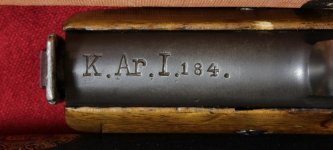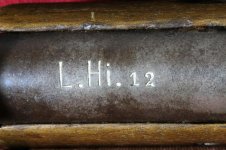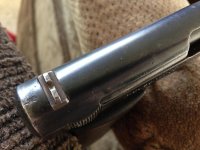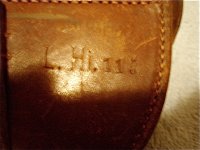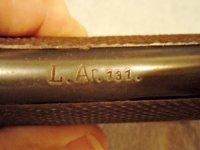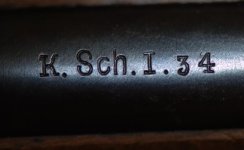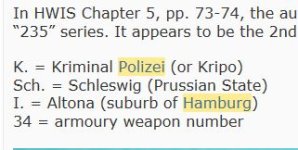Do we have any German Unit Marking specialists on the forum? I need some help in decyphering these markings on Mauser M 1910 pistols in caliber 32 ACP. Both pistols are marked 1920, indicating they went through the 1920 inventory of military weapons conducted by the Interallied Control Commission after WW I. So I wouldn't be surprised if both of these turned out to be police markings instead of military.
You are using an out of date browser. It may not display this or other websites correctly.
You should upgrade or use an alternative browser.
You should upgrade or use an alternative browser.
Unit Markings.
- Thread starter Cyrano
- Start date
Register to hide this ad
Absalom
SWCA Member, Absent Comrade
If they are .32/7.65mm, I assume you've got Mauser 1914's. I don't know how familiar you are with their history, but you can tell imperial from post-war production by the presence of the imperial acceptance mark in FRONT (not behind, they all have that) of the rear sight. The break was somewhere in the 180.000s.
I can't decipher the markings for you. My hunch would be that the first one is imperial military and the second one police. You should go to the Luger forum; that's where I got all my questions answered last year (I have a 1919 early post-war one; see picture below: no marks in front of sight).
Jan C Still Luger Pistols Central Powers Axis Pistols Discussion Boards From Gunboards.com
I can't decipher the markings for you. My hunch would be that the first one is imperial military and the second one police. You should go to the Luger forum; that's where I got all my questions answered last year (I have a 1919 early post-war one; see picture below: no marks in front of sight).
Jan C Still Luger Pistols Central Powers Axis Pistols Discussion Boards From Gunboards.com
Attachments
Last edited:
I misplaced my brain today: they're Model 1914 Mausers in 32 ACP. I just looked at them again; neither has the German Army acceptance mark in front of the rear sight, although of course both have the double crowns over U of the civilian proof behind the rear sight. The few police markings I've seen usually are something like S. P (abbreviation for the city of other political division), rack number, so these may be post WW I military.
Incidently, a close inspection will reveal that the two crowns of the proof mark are different. The top one has three lobes and is probably the imperial German crown, while the lower crown is probably the royal crown of Prussia.
Incidently, a close inspection will reveal that the two crowns of the proof mark are different. The top one has three lobes and is probably the imperial German crown, while the lower crown is probably the royal crown of Prussia.
The first one,,don't know really. I'd guess the 'K' was Kommando (Command). Though it could be Cavalry (Kavallerie(sp?)
There's another possibility for the K,,though I'm not really sure on this one,,and it's that of a Coastal Defense Group.
That may immedietly draw a conclusion that the 'Ar' is for Artillery,,but that's usually just 'A' for field artillery and Af for foot artillery. These WW1 markings are confusing at best as they seem not to follow the rules most of the time.
#2 is I believe Weimar Era Police marking.
'L' is for the Landjagerei (sp?)
A rural police/constabulary force.
The Administrative District (Hi) is Hildeshiem.
The '12' is weapon number. If it had been a Roman Numeral it would have been a Police District or Precinct within the Administrative District of Hildeshiem.
The weapon number will follow the police district numeral if both are present.
This is a Prussian State Police Marking,,1932 to about 1937/38.
There's another possibility for the K,,though I'm not really sure on this one,,and it's that of a Coastal Defense Group.
That may immedietly draw a conclusion that the 'Ar' is for Artillery,,but that's usually just 'A' for field artillery and Af for foot artillery. These WW1 markings are confusing at best as they seem not to follow the rules most of the time.
#2 is I believe Weimar Era Police marking.
'L' is for the Landjagerei (sp?)
A rural police/constabulary force.
The Administrative District (Hi) is Hildeshiem.
The '12' is weapon number. If it had been a Roman Numeral it would have been a Police District or Precinct within the Administrative District of Hildeshiem.
The weapon number will follow the police district numeral if both are present.
This is a Prussian State Police Marking,,1932 to about 1937/38.
Last edited:
Absalom
SWCA Member, Absent Comrade
So here's what I've been able to find:
I think 2152hq is correct with his identification of the "Landjägerei Hildesheim". I haven't found another gun, but the picture below of a Luger holster with the L.Hi. plus number marking; the thread where I found it agreed on the meaning.
On the second gun, if it is a WW I military marking, the K would almost certainly stand for "Königlich" (Royal). However, if you look at the second picture below, the abbreviation Ar was used for the city of Arnsberg; if, as on the pictured Luger, L. Ar. is "Landjägerei Arnsberg", a case could be made that K. Ar. stands for "Kriminalpolizei Arnsberg", the criminal investigative police or detectives; the 1914 was one of the most commonly issued plainclothes pistols during the Weimar years until the arrival of the Walthers.
Just speculation, of course. But the absence of Imperial marks would make military unit stamps less likely.
I think 2152hq is correct with his identification of the "Landjägerei Hildesheim". I haven't found another gun, but the picture below of a Luger holster with the L.Hi. plus number marking; the thread where I found it agreed on the meaning.
On the second gun, if it is a WW I military marking, the K would almost certainly stand for "Königlich" (Royal). However, if you look at the second picture below, the abbreviation Ar was used for the city of Arnsberg; if, as on the pictured Luger, L. Ar. is "Landjägerei Arnsberg", a case could be made that K. Ar. stands for "Kriminalpolizei Arnsberg", the criminal investigative police or detectives; the 1914 was one of the most commonly issued plainclothes pistols during the Weimar years until the arrival of the Walthers.
Just speculation, of course. But the absence of Imperial marks would make military unit stamps less likely.
Attachments
I think Absalom has #1 figured. Don't know why I thought the markings were necessarily Military.
Weimar Era Police makes perfect sense.
'K' KriminalPolizei, 'Ar' (Arnsberg), 'I' (Police District/Precinct 1), '184' (Weapon #184).
Looks like the pistol was scrubbed of an earlier applied number and this one applied. Not unusual either for recycled WW1 issue pieces or post WW1 production guns.
(Now I have to go pull my 1914 out and see what the grip strap markings are. I've forgotten, it's been a while since the thing has been out to the range. They are nice shooting handguns.)
Weimar Era Police makes perfect sense.
'K' KriminalPolizei, 'Ar' (Arnsberg), 'I' (Police District/Precinct 1), '184' (Weapon #184).
Looks like the pistol was scrubbed of an earlier applied number and this one applied. Not unusual either for recycled WW1 issue pieces or post WW1 production guns.
(Now I have to go pull my 1914 out and see what the grip strap markings are. I've forgotten, it's been a while since the thing has been out to the range. They are nice shooting handguns.)
Absalom
SWCA Member, Absent Comrade
vrichard: Your serial number, 67748, is somewhat earlier than my two pistols: 252401 and 254198. It was probably made during WW I. If it was accepted by the military, there will be a very small crown and gothic letter in front of the rear sight. If so, the markings are most likely military rather than police. Please let us know if yours has the miltiary acceptance stamp, and we'll go from there.
Similar threads
- Replies
- 47
- Views
- 3K
- Replies
- 9
- Views
- 2K
- Replies
- 47
- Views
- 7K
- Replies
- 39
- Views
- 2K
- Replies
- 39
- Views
- 3K

